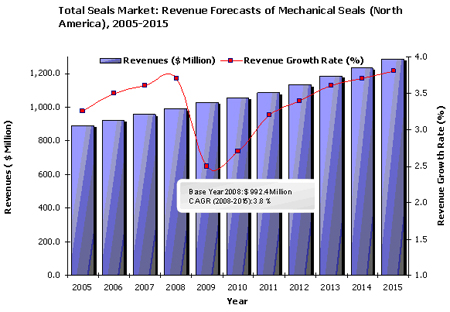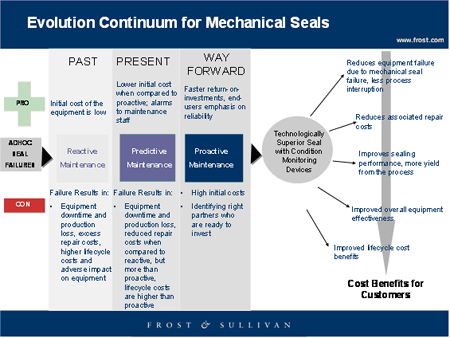Frost & Sullivan estimates the total North American mechanical seals market revenues at $992.4.0 million in 2008. Figure 1 shows the revenue trend for the North American mechanical seals market for 2005-2015. In the current economic downturn, the mechanical seals market is expected to experience a growth rate decline until mid-2010, but is likely to grow to generate $1,287.2 million by 2015. (Note: North America is defined as the United States, Canada and Mexico for this research.)

Figure 1 Source: Frost & Sullivan
Key Market Drivers
Key issues expected to positively affect seal demand include:
- Strong Environmental Protection Agency (EPA) guidelines and an intense need to reduce fugitive emissions in rotating equipment. Oil and gas, chemical, food and beverage, and pharmaceutical applications require superior sealing ability to prevent contamination of the end-product.
- Customers worldwide are focused on improving overall equipment performance to reduce operational costs and productivity losses. Mechanical seals have helped reduce equipment downtime due to high performance.
- Investments in the oil and gas sector are expected to continue beyond the current economic downturn, according to OPEC's forecasts.
Retrofits market opportunities will exist due to the aging plant population in the United States.
Return on Assets (ROA) and Total Cost of Ownership (TCO): The Future of Seals
While growth trends in the market are certainly of interest, expected future attributes of seals technology and monitoring are hot topics. The remaining comments focus on these key areas, including supply chain technology contributions, proactive and preventive maintenance and intelligent monitoring and support systems.
Technology Trends in Supply Chain
Mechanical seals form a crucial part of rotating equipment, since poor performance or failure results in yield loss. Incremental changes in the materials and sealing surface compositions of mechanical seals have addressed challenges such as dry running conditions and failures due to operator mishandling and various other failures. Suppliers of sealing surfaces have been consistently focusing on two major aspects: (a) improving the performance by employing coatings and (b) specific structuring on sliding surfaces.
A major factor contributing to seal failure is dry running; improving the performance of the sliding surface can drastically reduce these failures. Small grooves of special patterns are formed on these sliding surfaces and the grooves act as lubrication pockets during pump start-up or in the absence of adequate lubrication. This forms a thin film of lubrication, which reduces the initial friction coefficient on the surface and the energy consumption.
There have also been incremental innovations in improving the surface characteristics with coatings to prevent pump failure in dry running conditions or the handling of corrosive liquids. Diamond coatings and polycrystalline diamond coatings are being employed for seal rings used in high wear applications. These incremental changes in mechanical seal components have enhanced the performance of mechanical seals, aid in reducing energy consumption, improve the life of the seal, reduce the life cycle costs and decrease the risk of premature seal failure, thereby enhancing ROA and reducing TCO.
Reducing TCO: Preventive Maintenance and Condition Monitoring
Mechanical seal life can be enhanced by proper sizing for appropriate applications, operator awareness and proper employment of fluids per manufacturer specifications. Effective maintenance of rotary equipment also affects seal life. Preventive and proactive maintenance are two methods in which proper maintenance of the seal can be ensured. Preventive maintenance of the mechanical seal involves measuring discrepancies during operation through instrumentation such as pressure and temperature switches or transmitters, and other instrumentation devices. This reduces overall downtime costs.
Proactive maintenance monitors seal health and uses a multi-tier approach by providing information on equipment condition, intensity of discrepancy and severity of inconsistent performance. It may employ intelligent controls that can take necessary corrective action. Dual seals with intelligent support system are one example. These systems reduce the costs incurred in repair, production loss and process interruptions from intermittent pump or compressor failure.
End users also use condition monitoring to monitor the seal condition based on parameters such as seal face temperature or collapse of lubrication film so that appropriate measures are taken to solve the problem. One method of identifying seal life is measuring the lubrication film thickness. Two technologies help measure the seal's lubrication film thickness:
- A laser interferometer, which is restricted to laboratory applications
- Reflection of ultrasonic waves: the amplitude of reflected ultrasonic waves measures the degree of contact between seal faces and intensity of collapse of lubricating film. However, there have been several challenges in mounting the instrument without disturbing the seal design.

Figure 2 (Source: Frost & Sullivan)
On-board condition monitoring set-up decreases seal failure rates, which in turn diminishes production loss that occurs due to mid-cycle shutdown. The adoption of these technologies is mainly in applications where the rotating equipment's health is considered crucial. For instance, upstream oil and gas employs equipment without spare resources, and equipment stoppage in those applications causes significant production loss for its end users. Other applications include downstream oil refining, chemicals production and in centrifugal gas compressors used in downstream applications. In addition, they are also found in mixers, agitators and reactors where expensive chemicals are produced in batches. The size of the mixer vessel is huge and seal size and configuration varies for these applications. The mid-cycle breakdown of equipment due to seal failure can result in the loss of an entire batch of expensive chemicals in these applications.
On-Board CM and Intelligent Support Systems: Prospective Technologies
On-board condition monitoring can help reduce the costs associated with untimely equipment failure or seal failure. It identifies the indicators of poor performance and sends an alarm to the appropriate operator to take suitable action to rectify those parameters, which in turn significantly reduces the repair cost. This also saves costs associated with production losses.
However, mounting those devices or adding pressure switches, temperature switches or any relevant equipment without changing the seal design offers a tough challenge to seal manufacturers. Emergence of nanotechnology has resolved some of these hurdles. However, lack of availability of transmitters, proximity devices, and temperature and pressure sensors in a nano scale is still a prime challenge. Future technologies that can convert these devices into nano components and incorporate them into mechanical seals are anticipated to increase adoption of on-board condition monitoring, which is expected to be a truly revolutionary development in seal construction and performance.

